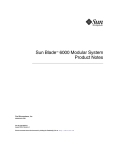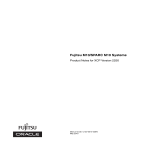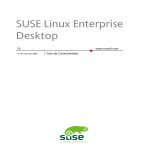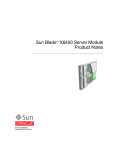Download - Oracle Documentation
Transcript
SPARC T5-1B Server Module Product Notes Part No: E35201-09 October 2015 Part No: E35201-09 Copyright © 2013, 2015, Oracle and/or its affiliates. All rights reserved. This software and related documentation are provided under a license agreement containing restrictions on use and disclosure and are protected by intellectual property laws. Except as expressly permitted in your license agreement or allowed by law, you may not use, copy, reproduce, translate, broadcast, modify, license, transmit, distribute, exhibit, perform, publish, or display any part, in any form, or by any means. Reverse engineering, disassembly, or decompilation of this software, unless required by law for interoperability, is prohibited. The information contained herein is subject to change without notice and is not warranted to be error-free. If you find any errors, please report them to us in writing. If this is software or related documentation that is delivered to the U.S. Government or anyone licensing it on behalf of the U.S. Government, then the following notice is applicable: U.S. GOVERNMENT END USERS. Oracle programs, including any operating system, integrated software, any programs installed on the hardware, and/or documentation, delivered to U.S. Government end users are "commercial computer software" pursuant to the applicable Federal Acquisition Regulation and agency-specific supplemental regulations. As such, use, duplication, disclosure, modification, and adaptation of the programs, including any operating system, integrated software, any programs installed on the hardware, and/or documentation, shall be subject to license terms and license restrictions applicable to the programs. No other rights are granted to the U.S. Government. This software or hardware is developed for general use in a variety of information management applications. It is not developed or intended for use in any inherently dangerous applications, including applications that may create a risk of personal injury. If you use this software or hardware in dangerous applications, then you shall be responsible to take all appropriate fail-safe, backup, redundancy, and other measures to ensure its safe use. Oracle Corporation and its affiliates disclaim any liability for any damages caused by use of this software or hardware in dangerous applications. Oracle and Java are registered trademarks of Oracle and/or its affiliates. Other names may be trademarks of their respective owners. Intel and Intel Xeon are trademarks or registered trademarks of Intel Corporation. All SPARC trademarks are used under license and are trademarks or registered trademarks of SPARC International, Inc. AMD, Opteron, the AMD logo, and the AMD Opteron logo are trademarks or registered trademarks of Advanced Micro Devices. UNIX is a registered trademark of The Open Group. This software or hardware and documentation may provide access to or information about content, products, and services from third parties. Oracle Corporation and its affiliates are not responsible for and expressly disclaim all warranties of any kind with respect to third-party content, products, and services unless otherwise set forth in an applicable agreement between you and Oracle. Oracle Corporation and its affiliates will not be responsible for any loss, costs, or damages incurred due to your access to or use of third-party content, products, or services, except as set forth in an applicable agreement between you and Oracle. Documentation Accessibility For information about Oracle's commitment to accessibility, visit the Oracle Accessibility Program website at http://www.oracle.com/pls/topic/lookup?ctx=acc&id=docacc. Access to Oracle Support Oracle customers that have purchased support have access to electronic support through My Oracle Support. For information, visit http://www.oracle.com/pls/topic/lookup? ctx=acc&id=info or visit http://www.oracle.com/pls/topic/lookup?ctx=acc&id=trs if you are hearing impaired. Référence: E35201-09 Copyright © 2013, 2015, Oracle et/ou ses affiliés. Tous droits réservés. Ce logiciel et la documentation qui l’accompagne sont protégés par les lois sur la propriété intellectuelle. Ils sont concédés sous licence et soumis à des restrictions d’utilisation et de divulgation. Sauf stipulation expresse de votre contrat de licence ou de la loi, vous ne pouvez pas copier, reproduire, traduire, diffuser, modifier, breveter, transmettre, distribuer, exposer, exécuter, publier ou afficher le logiciel, même partiellement, sous quelque forme et par quelque procédé que ce soit. Par ailleurs, il est interdit de procéder à toute ingénierie inverse du logiciel, de le désassembler ou de le décompiler, excepté à des fins d’interopérabilité avec des logiciels tiers ou tel que prescrit par la loi. Les informations fournies dans ce document sont susceptibles de modification sans préavis. Par ailleurs, Oracle Corporation ne garantit pas qu’elles soient exemptes d’erreurs et vous invite, le cas échéant, à lui en faire part par écrit. Si ce logiciel, ou la documentation qui l’accompagne, est concédé sous licence au Gouvernement des Etats-Unis, ou à toute entité qui délivre la licence de ce logiciel ou l’utilise pour le compte du Gouvernement des Etats-Unis, la notice suivante s’applique: U.S. GOVERNMENT END USERS. Oracle programs, including any operating system, integrated software, any programs installed on the hardware, and/or documentation, delivered to U.S. Government end users are "commercial computer software" pursuant to the applicable Federal Acquisition Regulation and agency-specific supplemental regulations. As such, use, duplication, disclosure, modification, and adaptation of the programs, including any operating system, integrated software, any programs installed on the hardware, and/or documentation, shall be subject to license terms and license restrictions applicable to the programs. No other rights are granted to the U.S. Government. Ce logiciel ou matériel a été développé pour un usage général dans le cadre d’applications de gestion des informations. Ce logiciel ou matériel n’est pas conçu ni n’est destiné à être utilisé dans des applications à risque, notamment dans des applications pouvant causer des dommages corporels. Si vous utilisez ce logiciel ou matériel dans le cadre d’ applications dangereuses, il est de votre responsabilité de prendre toutes les mesures de secours, de sauvegarde, de redondance et autres mesures nécessaires à son utilisation dans des conditions optimales de sécurité. Oracle Corporation et ses affiliés déclinent toute responsabilité quant aux dommages causés par l’utilisation de ce logiciel ou matériel pour ce type d’applications. Oracle et Java sont des marques déposées d’Oracle Corporation et/ou de ses affiliés. Tout autre nom mentionné peut correspondre à des marques appartenant à d’autres propriétaires qu’Oracle. Intel et Intel Xeon sont des marques ou des marques déposées d’Intel Corporation. Toutes les marques SPARC sont utilisées sous licence et sont des marques ou des marques déposées de SPARC International, Inc. AMD, Opteron, le logo AMD et le logo AMD Opteron sont des marques ou des marques déposées d’Advanced Micro Devices. UNIX est une marque déposée d’The Open Group. Ce logiciel ou matériel et la documentation qui l’accompagne peuvent fournir des informations ou des liens donnant accès à des contenus, des produits et des services émanant de tiers. Oracle Corporation et ses affiliés déclinent toute responsabilité ou garantie expresse quant aux contenus, produits ou services émanant de tiers, sauf mention contraire stipulée dans un contrat entre vous et Oracle. En aucun cas, Oracle Corporation et ses affiliés ne sauraient être tenus pour responsables des pertes subies, des coûts occasionnés ou des dommages causés par l’accès à des contenus, produits ou services tiers, ou à leur utilisation, sauf mention contraire stipulée dans un contrat entre vous et Oracle. Accessibilité de la documentation Pour plus d’informations sur l’engagement d’Oracle pour l’accessibilité à la documentation, visitez le site Web Oracle Accessibility Program, à l’adresse http://www.oracle.com/ pls/topic/lookup?ctx=acc&id=docacc. Accès au support électronique Les clients Oracle qui ont souscrit un contrat de support ont accès au support électronique via My Oracle Support. Pour plus d’informations, visitez le site http://www.oracle.com/ pls/topic/lookup?ctx=acc&id=info ou le site http://www.oracle.com/pls/topic/lookup?ctx=acc&id=trs si vous êtes malentendant. Contents Using This Documentation ................................................................................. 7 Product Documentation Library ......................................................................... 7 Feedback ....................................................................................................... 7 Late-Breaking Information .................................................................................. 9 Supported Chassis ........................................................................................... 9 Preinstalled Software ..................................................................................... 10 IMPORTANT - Install Latest OS Updates, Patches, and Firmware .......................... 10 Minimum Supported Versions of the Firmware, OS, and Software .......................... 11 Mandatory Oracle Solaris 11 OS Package Updates .............................................. 12 Mandatory Oracle Solaris 10 OS Patches ........................................................... 12 Oracle Solaris 10 1/13 Mandatory Patches ................................................. 13 Oracle Solaris 10 8/11 Mandatory Patches ................................................. 13 Oracle Solaris 10 9/10 Mandatory Patches ................................................. 13 ▼ Obtain Patches ................................................................................. 14 Configuring Server Module Power Usage .......................................................... 14 Server Module Power Management .......................................................... 15 ▼ Limit Power Usage ........................................................................... 16 Known Issues ............................................................................................... 19 When You Create Logical Domains, Some Memory Is Reserved By the Server .................................................................................................. 20 rKVMS Does Not Support Redirecting Storage From a SPARC Client (15795058) ........................................................................................... 20 Mouse Pointer Is Not Aligned With the Cursor in a Remote Window (15798251) ........................................................................................... 20 File Descriptor Leakage in libldom/ldom_xmpp_client.c (15811297) ............ 22 Spurious sunos.eft.unexpected_telemetry Faults Might be Reported (15820471) ........................................................................................... 22 ilomconfig Might Report Internal Error (15823485) ............................... 24 Some USB 3.0 Devices Cause Timeouts and Might Hang the Host (16019551 and 15985683) ...................................................................................... 25 5 Contents Link error on port 3 Warning (16038894) ............................................ 26 Drive OK to Remove LED Might Not Illuminate When a Drive is Unconfigured (16051551) ....................................................................... 26 Unable to Start CLI Shell from CMM to Reach the SP of the Server Module (16093666) ........................................................................................... 28 iPOST power-on-reset, error-reset, and hw-change Triggers Do Not Work (16192025) ........................................................................................... 28 Oracle ILOM Gets Confused When Multiple ldmd Configuration Files Exist With the Same Name (16239544) ............................................................. 30 Server Module Might Not Properly Connect to the Sun Blade 6000 Virtualized 40 GbE NEM (16299805) ....................................................................... 30 Infrequent SAS Disconnected command timeout Messages Might Be Displayed (16345218) ............................................................................ 31 CPU Power Management Can Lower Disk IOPS Performance (16355418) ....... 32 Oracle Solaris 10 OS Does Not Display Some Fault Information (16456603) ........................................................................................... 32 ldm unbind of an SDIO or SRIOV Domain Hangs (16426940) ...................... 33 6 SPARC T5-1B Server Module Product Notes • October 2015 Using This Documentation ■ ■ ■ Overview – Describes how to troubleshoot and maintain the server Audience – Technicians, system administrators, and authorized service providers Required knowledge – Advanced experience troubleshooting and replacing hardware Product Documentation Library Documentation and resources for this product and related products are available at http://www. oracle.com/goto/T5-1B/docs. Feedback Provide feedback about this documentation at http://www.oracle.com/goto/docfeedback. Using This Documentation 7 8 SPARC T5-1B Server Module Product Notes • October 2015 Late-Breaking Information These sections provide important information and late-breaking news about the server module: ■ ■ ■ ■ ■ ■ ■ ■ “Supported Chassis” on page 9 “Preinstalled Software” on page 10 “Minimum Supported Versions of the Firmware, OS, and Software” on page 11 “IMPORTANT - Install Latest OS Updates, Patches, and Firmware ” on page 10 “Mandatory Oracle Solaris 11 OS Package Updates” on page 12 “Mandatory Oracle Solaris 10 OS Patches” on page 12 “Configuring Server Module Power Usage” on page 14 “Known Issues” on page 19 Supported Chassis Several versions of Oracle's Sun Blade 6000 modular system have been available. The latest two versions support SAS-1 and SAS-2 modular components. Gen2-capable PCIe EMs and NEMs connected to this server module through the chassis run at Gen2 speeds. Gen1-capable devices run at Gen1 speeds. This server module is supported in the following chassis models: Chassis Minimum CMM Software Latest model (A90-D and 7105379) modular system 4.2 or later(provides Oracle ILOM 3.1.1.10) Previous model (A90-B) modular system 3.3.5 or later(provides Oracle ILOM 3.0.12.11.d) To determine your chassis version, refer to the section about chassis part numbers in the Sun Blade 6000 Modular System Service Manual. Late-Breaking Information 9 Preinstalled Software Preinstalled Software Software Location Description Oracle Solaris 11.1 OS The OS is installed on drive 0, using a ZFS file system. Host OS. /opt/SUNWldm Manages logical domains. /usr/lib/ep Provides early warning of the potential for specific FRU faults. /usr/sunvts Provides hardware validation tests. Oracle VM Server for SPARC† Electronic Prognostics Oracle VTS† † † These software components are part of the Oracle Solaris 11.1 OS distribution. The preinstalled OS is ready to be configured at the appropriate point when you first apply power to the server module. Mandatory package updates might not be preinstalled. Ensure that you obtain and install all mandatory updates before you put the server module into production. See “Mandatory Oracle Solaris 11 OS Package Updates” on page 12. Refer to the Oracle Solaris documentation for instructions on installing and configuring the Oracle Solaris OS. You can reinstall the OS, along with mandatory package updates or patches, instead of using the preinstalled OS. See “Minimum Supported Versions of the Firmware, OS, and Software” on page 11. IMPORTANT - Install Latest OS Updates, Patches, and Firmware Some product features are enabled only when the latest versions of patches or firmware are installed. In order to retain optimal performance, security, and stability, installing the latest available patches or firmware is required. Verify that the server module firmware version is at a minimum 9.5.1.B or higher. 1. Check the system firmware: From the ILOM web interface, click System Information → Summary, then view the property value for the System Firmware Version in the General Information table. From the command prompt, type: -> show /HOST 10 SPARC T5-1B Server Module Product Notes • October 2015 Minimum Supported Versions of the Firmware, OS, and Software 2. Ensure the server firmware version is at the minimum required version, shown above, or a subsequent release, if available. 3. If required, download the latest available software release version from My Oracle Support at: https://support.oracle.com 4. If required, update the server firmware. Refer to the information about performing firmware updates in the Oracle ILOM Administrator's Guide for Configuration and Maintenance. Ensure that you perform the preparatory steps described in that document before updating the firmware. Minimum Supported Versions of the Firmware, OS, and Software Oracle Solaris 11 is the recommended OS for T5-1B server modules. The advantages of Oracle Solaris 11 include simplified installation and maintenance, enhanced virtualization capabilities, and performance enhancements. A more detailed list of Oracle Solaris 11 advantages can be found at: http://www.oracle.com/technetwork/server-storage/solaris11/overview/solarismatrix-1549264.html If you configure the server with Oracle VM Server for SPARC, you can install various combinations of the minimum (or later) versions of the OS. For example, you can use Oracle Solaris 11.1 with SRU 4.6 for the control domain, and Oracle Solaris 10 9/10 in guest domains. Note - Oracle VM Server for SPARC 3.1.1 requires firmware version 9.1.2.d. Oracle Solaris 11.1 SRU 17 (11.1.17.5.0) contains Oracle VM Server for SPARC 3.1.1. Software Minimum Supported Versions Sun System Firmware 9.0.0.c or later supported release The firmware includes Oracle ILOM 3.2.1 or later Oracle Solaris 11 OS For the control domain, guest domains, and nonvirtualized configurations: Oracle Solaris 11.1 SRU 4.6 Includes these software components: ■ Oracle VM Server for SPARC 3.0.0.2 ■ Oracle Electronic Prognostics ■ Oracle VTS 7.0 PS 15 Also see “Mandatory Oracle Solaris 11 OS Package Updates” on page 12. Late-Breaking Information 11 Mandatory Oracle Solaris 11 OS Package Updates Software Minimum Supported Versions Oracle Solaris 10 OS ■ For the control domain, guest domains, and nonvirtualized configurations: Oracle Solaris 10 1/13 plus patches and the SUNWldm package (from the Oracle VM Server for SPARC software) ■ For guest domains only: Oracle Solaris 10 9/10 OS or Oracle Solaris 10 8/11 OS, plus Oracle Solaris 10 1/13 SPARC Bundle and patches. The Oracle Solaris 10 OS includes Oracle VTS 7 PS15. Oracle Electronic Prognostics 1.3 is not included, but you can install it separately. Also see “Mandatory Oracle Solaris 10 OS Patches” on page 12. Mandatory Oracle Solaris 11 OS Package Updates No package update is required at this time to use the preinstalled Oracle Solaris 11.1 OS with this server module. If you reinstall the OS, you might need to install certain package updates before you put the server module and optional hardware or software components into production. The server module requires at least Oracle Solaris 11.1 SRU 4.6. Install the most recent Oracle Solaris 11.1 Support Repository Update (SRU). Taking this action ensures that your server module has the latest software for the best performance, security, and stability. Use the pkg info entire command to display which SRU is currently installed on your server module. Use the pkg command or the package manager GUI to download any available SRUs from the update repository (https://pkg.oracle.com/solaris/support). Note - To access the Oracle Solaris 11 package update repository, you must have an Oracle support agreement that enables you to install a required SSL certificate and support key. Refer to the article at: http://www.oracle.com/technetwork/articles/servers-storage-admin/ o11-018-howto-update-s11-1572261.html Go to Oracle's certificate request web site at: https://pkg-register.oracle.com. Mandatory Oracle Solaris 10 OS Patches If you choose to install the Oracle Solaris 10 OS, you must also install additional patches, and in some cases, a patch bundle. 12 SPARC T5-1B Server Module Product Notes • October 2015 Mandatory Oracle Solaris 10 OS Patches Oracle Solaris 10 1/13 Mandatory Patches This version of the OS is supported in the control domain, guest domains, or for nonvirtualized configurations. Installation Order OS or Patch 1 Oracle Solaris 10 1/13 OS 2 Mandatory patches: ■ ■ ■ ■ ■ ■ ■ ■ ■ 3 148322-07 (or higher) 148324-06 (or higher) 148888-01 (or higher) 149638-01 (or higher) 149644-01 (or higher) 150011-02 (or higher) 150025-01 (or higher) 150027-01 (or higher) 150107-01 (or higher) SUNWldm package (from the Oracle VM Server for SPARC software) Oracle Solaris 10 8/11 Mandatory Patches This version of the OS is supported only in guest domains. Installation Order OS or Patch 1 Oracle Solaris 10 8/11 OS 2 Oracle Solaris 10 1/13 SPARC Bundle 3 All of the Oracle Solaris 10 1/13 mandatory patches. See “Oracle Solaris 10 1/13 Mandatory Patches” on page 13. Note - Until the Oracle Solaris 10 1/13 SPARC Bundle is installed, you might encounter these Oracle Solaris bugs—15712380, 15704520, 15665037. The first two bugs are resolved when the Oracle Solaris 10 1/13 SPARC Bundle is installed. These bugs do not impact the patch installations. Oracle Solaris 10 9/10 Mandatory Patches This OS is supported only in guest domains. Late-Breaking Information 13 Obtain Patches Installation Order OS or Patch 1 Oracle Solaris 10 9/10 OS 2 Oracle Solaris 10 1/13 SPARC Bundle 3 All of the Oracle Solaris 10 1/13 mandatory patches. See “Oracle Solaris 10 1/13 Mandatory Patches” on page 13. Note - Until the Oracle Solaris 10 1/13 SPARC Bundle is installed, you might encounter these Oracle Solaris bugs—15712380, 15704520, 15665037. The first two bugs are resolved when the Oracle Solaris 10 1/13 SPARC Bundle is installed. These bugs do not impact the patch installations. Obtain Patches Perform these steps to obtain patches for the Oracle Solaris 10 OS. 1. Sign in to My Oracle Support: Go to: https://support.oracle.com 2. Select the Patches & Updates tab. 3. Search for a patch using the Patch Search panel. When searching for a patch using the Patch Name or Number field, you must specify the complete name or number of the patch. For example: ■ Solaris 10 1/13 SPARC Bundle ■ 13058415 ■ 147159-03 To search using a patch number without the revision number (last two digits), type % in place of the revision number. For example: 14159-% 4. Once you locate the patch, access the README and download the patch from the site. The patch README provides the patch installation instructions. Configuring Server Module Power Usage These topics describe how to configure the server module power usage: 14 SPARC T5-1B Server Module Product Notes • October 2015 Obtain Patches ■ ■ “Server Module Power Management” on page 15 “Limit Power Usage” on page 16 Server Module Power Management Because the Sun Blade 6000 modular system accommodates a variety of different server, storage, and I/O modules, it is possible to create a configuration that might exceed the power that the modular system can provide. You can use several tools and techniques to manage the power used by the modular components: ■ ■ ■ Sun Blade Modular System Power Calculator – Provides guidance for estimating systemlevel worst-case electrical loads for modular components. To access the tool go to: http://www.oracle.com/us/products/servers-storage/sun-power-calculators/ calc/6000chassis-power-calculator.html Oracle ILOM – Provides configuration properties for power consumption and alert notifications. For details, refer to the Oracle ILOM Administrator's Guide for Configuration and Maintenance, setting power alert notifications and managing system power usage. SPARC T5 power limiting feature – Enables you to tune the power policy settings to match the server module's performance requirements. This feature is particularly useful for the SPARC T5-1B server module. You can lower power numbers to increase the number of server modules that can be installed in a chassis. However, the CPU might be throttled during certain work loads, especially under peak load conditions. This figure and table provide an example of performance degradation that a server module might experience under three types of benchmark loads for a range of power limits. This example assumes that the modular system contains like-configured SPARC T5-1B server modules with 256-Gbytes of memory. The default maximum power budget available to each server module is 680W. Late-Breaking Information 15 Limit Power Usage Number of Installed Server Modules Required Power Limit Per Server Module Percent Performance Degradation SPECjbb CINT2000 CFP2000 1-7 none (default 680W) 0% 0% 0% 8 604W 0% 1% 3% 9 537W 5% 7% 11% 10 483W 12% 16% 19% Contact your Oracle service provider for more details. For instructions on how to use the power limit feature see “Limit Power Usage” on page 16. Limit Power Usage Use this procedure to lower the power limit used by individual SPARC T5-1B server modules so that more server modules can be used in the chassis. For comprehensive instructions about the Oracle ILOM commands listed in this procedure, refer to the Oracle ILOM Administrator's Guide for Configuration and Maintenance, setting power alert notifications and managing system power usage. 16 SPARC T5-1B Server Module Product Notes • October 2015 Limit Power Usage 1. If you are adding server modules to a modular system that is already running with other components, identify your available power budget. a. Log into the Oracle ILOM browser interface on the CMM. In a browser address field, enter the CMM's IP address, press Return, and log in. b. In the left panel, click Power Management > Allocation. The Power Allocation Plan is displayed. c. In the Blade Slot Power Summary table, note the watts listed for grantable power. This value is your power budget for adding additional components. 2. Use the power calculator to compute the power needs of each SPARC T5-1B server module. Go to: http://www.oracle.com/us/products/servers-storage/sun-power-calculators/ calc/6000chassis-power-calculator.html Late-Breaking Information 17 Limit Power Usage 3. If the desired number of server modules exceeds the power budget, identify a power budget for each server module. Select a power budget lower than the lowest power budget suggested by the calculator. When you apply the lower power budget to the server modules, you can install more server modules in the chassis. 4. Install all the additional server modules into the modular system. Refer to the SPARC T5-1B Server Module Installation Guide for details. 5. For each SPARC T5-1B server module, set the power limit: a. In the Oracle ILOM CMM browser interface, go to the server module page. In the upper left corner, in the Manage pull-down menu, select the server module. b. In the Actions panel, turn off the power. c. In the left navigation panel, select Power Management > Limit. d. Enter your power budget value in the Target Limit field, select Hard for the Policy setting, and click Save. Set the Target Limit between the minimum power drawn by the server module and the maximum power the server module is permitted to consume (peak permitted). e. Power on the host. Return to the Summary page and power up the server module. 18 SPARC T5-1B Server Module Product Notes • October 2015 Known Issues 6. Repeat Step 1 to verify that all components are running within the available power budget. If you need to make additional adjustments, repeat Step 5. Known Issues These topics detail the known issues for Oracle's SPARC T5-1B server module. ■ ■ ■ “When You Create Logical Domains, Some Memory Is Reserved By the Server” on page 20 “rKVMS Does Not Support Redirecting Storage From a SPARC Client (15795058)” on page 20 “Mouse Pointer Is Not Aligned With the Cursor in a Remote Window (15798251)” on page 20 ■ “File Descriptor Leakage in libldom/ldom_xmpp_client.c (15811297)” on page 22 ■ “Spurious sunos.eft.unexpected_telemetry Faults Might be Reported (15820471)” on page 22 ■ “ilomconfig Might Report Internal Error (15823485)” on page 24 “Some USB 3.0 Devices Cause Timeouts and Might Hang the Host (16019551 and 15985683)” on page 25 ■ ■ ■ ■ “Link error on port 3 Warning (16038894)” on page 26 “Drive OK to Remove LED Might Not Illuminate When a Drive is Unconfigured (16051551)” on page 26 “Unable to Start CLI Shell from CMM to Reach the SP of the Server Module (16093666)” on page 28 ■ “iPOST power-on-reset, error-reset, and hw-change Triggers Do Not Work (16192025)” on page 28 ■ “Oracle ILOM Gets Confused When Multiple ldmd Configuration Files Exist With the Same Name (16239544)” on page 30 “Server Module Might Not Properly Connect to the Sun Blade 6000 Virtualized 40 GbE NEM (16299805)” on page 30 ■ ■ ■ ■ ■ “Infrequent SAS Disconnected command timeout Messages Might Be Displayed (16345218)” on page 31 “CPU Power Management Can Lower Disk IOPS Performance (16355418)” on page 32 “Oracle Solaris 10 OS Does Not Display Some Fault Information (16456603)” on page 32 “ldm unbind of an SDIO or SRIOV Domain Hangs (16426940)” on page 33 Late-Breaking Information 19 Known Issues When You Create Logical Domains, Some Memory Is Reserved By the Server When you use Oracle VM Server for SPARC, you can assign most of the memory in a SPARC T5 server to logical domains. However, a small portion of the server's memory is preassigned to software components, the hypervisor, and certain I/O devices. To determine which portions of memory are unavailable for logical domains, type this command: # ldm ls-devices -a mem In the output, look for rows that include _sys_ in the Bound column. Each of those portions of memory is not available for logical domains. rKVMS Does Not Support Redirecting Storage From a SPARC Client (15795058) Note - This issue has been fixed in FW 9.0.2.g. Starting the Storage feature of Java Remote Console Plus on an Oracle Solaris system is not supported. Workaround: Start the Storage feature of Java Remote Console Plus on a Linux or Windows system. For a complete list of supported browsers, operating systems, and platforms, refer to the Oracle ILOM Administrator's Guide for Configuration and Maintenance. Mouse Pointer Is Not Aligned With the Cursor in a Remote Window (15798251) Note - This issue has been fixed in Oracle Solaris 11 SRU 11.1.9.5.1. The mouse pointer in the Oracle ILOM video remote console might not track well. The cursor position might be out of sync with the Xorg server on the Oracle Solaris host, a condition that makes mouse navigation and selection difficult. Workaround A: For a quick but not permanent fix, log in to the Gnome desktop and type this command in a terminal window: xset m 1 1 20 SPARC T5-1B Server Module Product Notes • October 2015 Known Issues This change is not permanent, but immediately makes it easier for you to navigate with the mouse and enables you to perform steps that result in a more permanent change. If you have problems obtaining a terminal window, try one of these methods: ■ ■ ■ Click the right mouse button. When the desktop pop up is displayed, type: e Use the keyboard to obtain a terminal window by typing Alt-F2. Then type: gnome-terminal Select the desired terminal window as active by typing Alt-Tab. Workaround B: For a permanent and persistent fix, perform these steps: 1. Log in to the system on the Gnome desktop. 2. Choose Launch > System > Preferences > Mouse. Alternatively, you can reach this point by typing Alt-F2 and then typing: gnome-mouseproperties 3. Change the mouse preferences to these values: ■ ■ ■ Pointer Speed Acceleration = Slow Pointer Speed Sensitivity = Low Drag and Drop Threshold = Small If you are using the keyboard, navigate by pressing Tab until the desired item is highlighted. For each value, press the left arrow key to move the slides all the way to the left. These changes are permanent and persist after screen locks and logging out. Workaround C: In the Oracle Solaris 11 OS, you can use another method to initially disable problematic mouse acceleration. However, subsequent changes to the mouse acceleration during the Xorg session override the changes made by this method. 1. Open this file for editing: /etc/hal/fdi/preprobe/10osvendor/10-x11-input.fdi Ensure that you do not leave any other copies of the file in this directory. 2. Locate the following lines: <merge key="input.x11_options.StreamsModule" type="string">usbms</merge> <merge key="input.x11_options.Protocol" type="string">VUID</merge> 3. Following those lines, add these lines and save the file: <merge key="input.x11_options.AccelerationScheme" type="string">none</merge> <merge key="input.x11_options.AccelerationNumerator" type="string">1</merge> <merge key="input.x11_options.AccelerationDenominator" type="string">1</merge> <merge key="input.x11_options.AccelerationThreshold" type="string">1</merge> 4. Type these Oracle Solaris commands: Late-Breaking Information 21 Known Issues # svcadm restart hal # svcadm restart gdm File Descriptor Leakage in libldom/ ldom_xmpp_client.c (15811297) Note - This issue has been fixed in Oracle Solaris 11 SRU 11.1.5.5. The Oracle Solaris Predictive Self-Healing (PSH) fault manager daemon (fmd) can become nonoperational when the Logical Domains Manager (ldmd) is down for a period of time. On SPARC T5 series servers, I/O faults, including disk faults, are diagnosed by the Oracle Solaris fmd. Other faults are diagnosed by Oracle ILOM on the SP and are not affected by this bug. If a patch with the fix becomes available, you should install the patch. See “Obtain Patches” on page 14. Workaround: If you suspect that I/O faults are not being reported, perform these steps: 1. Determine whether or not the ldmd is online. If ldmd is online, then this bug is not the issue. Refer to the fault management procedures in the SPARC T5-1B Server Module Service Manual. If ldmd is offline, go to Step 2. 2. Restart ldmd. 3. Restart fmd. 4. View the system log files. If an I/O fault occurred while the fmd was not running, use information in the log files to isolate the problem. Spurious sunos.eft.unexpected_telemetry Faults Might be Reported (15820471) Note - This issue has been fixed in Oracle Solaris 11.1.4.6.0. A device reporting a large number of correctable errors continues to report errors while it is being disabled. Each error is queued and diagnosed in order. In rare cases, the last error reported by the device might be queued but not processed for diagnosis until after the device is disabled. 22 SPARC T5-1B Server Module Product Notes • October 2015 Known Issues This last error is reported as unexpected telemetry, because the device is no longer enabled in the system. For example: # fmadm faulty ------------------ ------------------------------------ -------------- -------Time UUID msgid Problem Status : solved Diag Engine : [unknown] System Manufacturer : Oracle Corporation Name : T5-1B Part_Number : 7045605 Serial_Number : xxxxxxxxxx Severity ---------------------------------------Suspect 1 of 2 Fault class : fault.sunos.eft.unexpected_telemetry Certainty : 50% Affects : dev:////pci@1040/pci@1/pci@0 Status : faulted but still in service ------------------- ------------------------------------ ---------------------FRU Status : faulty Location : Chassis Manufacturer : Oracle Corporation Name : T5-1B Part_Number : 7045605 Serial_Number : xxxxxxxxxx 2012-10-04/17:24:07 87732365-faa6-e9cd-bf2a-9052cb8cf876 SUNOS-8000-J0 Major ---------------------------------------Suspect 2 of 2 Fault class : defect.sunos.eft.unexpected_telemetry Certainty : 50% Affects : dev:////pci@1040/pci@1/pci@0 Status : faulted but still in service FRU Status : faulty Description: A fault has been diagnosed by the Host Operating System. Response : The service required LED on the chassis and on the affected FRU may be illuminated. Impact : No SP impact. Action : Refer to the associated reference document at http://support.oracle.com/msg/SUNOS-8000-J0 for the latest service procedures and policies regarding this diagnosis. Location : Chassis Late-Breaking Information 23 Known Issues Manufacturer Name Part_Number Serial_Number : : : : Oracle Corporation T5-1B 7045605 xxxxxxxxxx Workaround: You can ignore unexpected telemetry faults. To clear the fault, perform these steps: 1. Type the fmadm faulty command to obtain the fault UUID. # fmadm faulty ------------------Time Severity ------------------2012-10-04/17:24:07 --------------------------------- -------------- -------UUID msgid ... ---------------------------------- ---------------------87732365-faa6-e9cd-bf2a-9052cb8cf876 SUNOS-8000-J0 Major 2. Clear the unexpected telemetry fault in the Oracle Solaris host using the fault UUID. # fmadm repair 87732365-faa6-e9cd-bf2a-9052cb8cf876 ilomconfig Might Report Internal Error (15823485) The Oracle Solaris ilomconfig command that enables the communication channel between the OS and the SP might occasionally fail with an Internal Error message. This communication channel is enabled by default and is not usually disabled in the normal course of operation. However, the channel can be disabled by superuser with this Oracle Solaris command: # ilomconfig disable interconnect Host-to-ILOM interconnect disabled. Occasionally, the command to enable the interconnect might fail again with this error message: # ilomconfig enable interconnect ERROR: Internal error If this situation happens, follow the workaround to reenable the link, because the link is used for transferring diagnostic data between the Oracle Solaris instance and the SP and must be reenabled promptly. Workaround: Retype the command to enable the interconnect. 24 SPARC T5-1B Server Module Product Notes • October 2015 Known Issues # ilomconfig enable interconnect Host-to-ILOM interconnect successfully configured. If the failure persists, contact your authorized Oracle Service Provider for assistance. Some USB 3.0 Devices Cause Timeouts and Might Hang the Host (16019551 and 15985683) The two USB ports available on the front dongle of the server module are USB 2.0 compliant. If you use some USB 3.0 devices (especially those behind external USB hubs) to install the OS or to boot, the action might get stuck and display these messages: WARNING: /pci@340/pci@1/pci@0/pci@2/usb@0/hub@5/hub@3/storage@1/disk@0,0 (sd12): SCSI transport failed: reason 'timeout': giving up In some extreme cases, this situation might cause the host to experience a hard hang. Workaround: 1. Send a break to the host and connect to the host console using one of these methods: ■ Using the Oracle ILOM CLI: -> cd /HOST -> set send_break_action=break -> start /HOST/console ■ Using the Oracle ILOM web interface: a. Select Host Management > Power Control. b. Select Reset for Select Action and click Save. c. Click OK on the pop-up menu. 2. When the host reaches the ok prompt, remove any external hubs and attach the USB device directly to the front dongle or use another standard compliant USB device and retry the operation. 3. If the host does not display the ok prompt, remove any external hubs and attach the USB device directly to the front dongle port or use another standard USB-compliant device, then power cycle the host using one of these methods: ■ Using the Oracle ILOM CLI: -> reset /SYS ■ Using the Oracle ILOM web interface: Late-Breaking Information 25 Known Issues a. Select Host Management > Power Control. b. Select Reset for Select Action and click Save. c. Click OK on the pop-up menu. Link error on port 3 Warning (16038894) When powering up the server module with a USB device installed in the internal USB port socket, this warning message might be displayed: WARNING: /pci@340/pci@1/pci@0/pci@2/usb@0: Link error on port 3, resetting. Workaround: The warning message can be safely ignored. The device should be fully functional. If the device is not functional, contact Oracle Support for further assistance. Drive OK to Remove LED Might Not Illuminate When a Drive is Unconfigured (16051551) This issue only applies to server modules running the Oracle Solaris 10 1/13 OS. If you use the cfgadm command to unconfigure a drive, the drive's blue Ok to Remove LED might not illuminate. This issue makes it difficult to confirm that the drive is ready to be removed and to identify the drive's physical location. Workaround: Perform these steps to confirm that the drive is ready to be removed and to identify the drive's physical slot. 1. Use the cfgadm command to identify the drive's WWID that you plan to unconfigure. In this example, the fifth drive will be unconfigured. The fifth drive has a WWID of w5000c50033278c09,0. # cfgadm -al | grep disk c7::w5000cca016065039,0 c8::w5000cca0257b4999,0 c9::w5000cca0257ca335,0 c10::w5000cca03c252999,0 c13::w5000c50033278c09,0 disk-path disk-path disk-path disk-path disk-path connected connected connected connected connected 2. Unconfigure the drive. 26 SPARC T5-1B Server Module Product Notes • October 2015 configured configured configured configured configured unknown unknown unknown unknown unknown Known Issues # cfgadm -c unconfigure c13::w5000c50033278c09,0 3. Verify that the drive is unconfigured. # cfgadm -al | grep disk c7::w5000cca016065039,0 c8::w5000cca0257b4999,0 c9::w5000cca0257ca335,0 c10::w5000cca03c252999,0 c13::w5000c50033278c09,0 disk-path disk-path disk-path disk-path disk-path connected connected connected connected connected configured configured configured configured unconfigured unknown unknown unknown unknown unknown <<== If the drive Ok to Remove LED does not illuminate perform the remaining steps. 4. Send the output of the prtconf -v command to a file. # prtconf -v > /tmp/prtconf.out 5. Open the file with an editor and search for the WWID of the unconfigured drive (5000c50033278c09 in this procedure's example). 6. In the output, confirm the drive location and that the drive is offline. Look two lines above the WWID to identify the drive's location (HDD4 in this example) Look at the line after the line with the WWID. The word offline indicates the drive is unconfigured. disk, instance #13 (driver not attached) System software properties: name='ddi-devid-registrant' type=int items=1 value=00000001 Hardware properties: name='class' type=string items=1 value='scsi' name='inquiry-revision-id' type=string items=1 value='0B70' name='inquiry-product-id' type=string items=1 value='ST930003SSUN300G' name='inquiry-vendor-id' type=string items=1 value='SEAGATE' name='inquiry-device-type' type=int items=1 value=00000000 name='compatible' type=string items=4 value='scsiclass,00.vSEAGATE.pST930003SSUN300G.r0B70' + 'scsiclass,00.vSEAGATE.pST930003SSUN300G' + 'scsiclass,00' + 'scsiclass' name='client-guid' type=string items=1 value='5000c50033278c0b' location: /dev/chassis/SPARC_T5-2.1144BD5ZZZ//SYS/SASBP/HDD4/disk <== Location Late-Breaking Information 27 Known Issues Paths from multipath bus adapters: Path 5: /pci@3c0/pci@1/pci@0/pci@2/scsi@0/iport@1/disk@w5000c50033278c09,0 mpt_sas#7 (offline) <== Driver offline means drive is unconfigured. name='wwn' type=string items=1 value='5000c50033278c0b' name='lun' type=int items=1 value=00000000 name='lun64' type=int64 items=1 value=0000000000000000 name='target-port' type=string items=1 value='w5000c50033278c09' name='attached-port' type=string items=1 value='w508002000147f5b1' name='attached-port-pm' type=string items=1 value='1' name='target-port-pm' type=string items=1 value='1' name='phy-num' type=int items=1 value=00000000 name='obp-path' type=string items=1 value= '/pci@3c0/pci@1/pci@0/pci@2/scsi@0/disk@w5000c50033278c09,0' Unable to Start CLI Shell from CMM to Reach the SP of the Server Module (16093666) Starting with Oracle ILOM 3.1, remote drilldown enables a CMM to show (under /CH/BLx) the full CLI for the SP of a server module. If the CMM uses Oracle ILOM 3.1 or later, you no longer need to run the start cli command to access the SP of a SPARC T5-1B server module. iPOST power-on-reset, error-reset, and hw-change Triggers Do Not Work (16192025) Note - This issue has been fixed in Oracle ILOM 3.2.1. These Oracle ILOM properties control whether iPOST (Oracle ILOM POST) runs when the SP is booted: ■ 28 /SP/diag mode SPARC T5-1B Server Module Product Notes • October 2015 Known Issues ■ /SP/diag trigger By default, these properties are defined so that the execution of iPOST is disabled. For example: /SP/diag mode=off /SP/diag trigger=all-resets If you change /SP/diag mode to normal to enable iPOST, and if you change /SP/diag trigger from all-resets to any other value (power-on-reset, error-reset, or hw-change), iPOST will not run. In addition, these messages are displayed on the SER MGT port during the boot sequence indicating that iPOST did not run: ... Starting IPMI Stack: . Done Starting BBR daemon... bbrd started after 0 seconds. Starting SP fishwrap cache daemon: fishwrapd . Done FPGA iPOST skipped Starting Host daemon: hostd . Done Starting Network Controller Sideband Interface Daemon: ncsid . Done Starting Physical Domain Manager: pdm . Done Starting Platform Obfuscation Daemon: pod . Done Starting vbsc daemon: vbsc . Done ... Workaround: Perform these steps to enable iPOST: 1. Log in to Oracle ILOM. 2. Ensure that the host is not powered on. 3. Configure the Oracle ILOM diag properties: ■ From the Oracle ILOM CLI, type: -> set /SP/diag mode=normal -> set /SP/diag trigger=all-resets In the Oracle ILOM BUI, select System Management > Diagnostics. Select all three Trigger boxes and change the Mode to Normal. 4. Reset the SP. ■ The output on the system console indicates that iPOST is running: ... Starting IPMI Stack: . Done Starting BBR daemon... Late-Breaking Information 29 Known Issues bbrd started after 0 seconds. Starting SP fishwrap cache daemon: fishwrapd . Done Running FPGA iPOST Starting Host daemon: hostd . Done Starting Network Controller Sideband Interface Daemon: ncsid . Done Starting Physical Domain Manager: pdm . Done Starting Platform Obfuscation Daemon: pod . Done Starting vbsc daemon: vbsc . Done ... Oracle ILOM Gets Confused When Multiple ldmd Configuration Files Exist With the Same Name (16239544) Note - This issue has been fixed in Oracle ILOM 3.2.1. You can have multiple ldmd configuration files with various names. The names are casesensitive (that is, Alpha and alpha are different names), so you can have configuration files that use the same word. The Oracle ILOM UI names are case-insensitive (but case-preserving). Thus, multiple configuration file names like Alpha and alpha cause confusion in the Oracle ILOM UI. For example, if you type this command when there are multiple configuration file names, the UI hangs: -> show /HOSTx/domain/configs Workaround: Remove one of the case-matching ldmd configuration files. Then wait for the Oracle ILOM infrastructure to automatically restart the UI process. Server Module Might Not Properly Connect to the Sun Blade 6000 Virtualized 40 GbE NEM (16299805) In some cases, after resetting the server module, the server module is unable to detect one of the Sun Blade 60000 Virtualized 40 GbE NEM ports, or might incorrectly link to a port using Gen2 x4 instead of Gen2 x8. Fix: If you plan to connect the server module to a Sun Blade 6000 Virtualized 40 GbE NEM you must install the patch that updates the server module firmware: 30 SPARC T5-1B Server Module Product Notes • October 2015 Known Issues 1. Obtain the firmware patch for this server module. Patch name: Hardware_Programmables-1.0.0-SPARC_T5-1B.pkg Patch number: 17019100 See “Obtain Patches” on page 14. 2. Follow the installation instructions in the patch README file. Infrequent SAS Disconnected command timeout Messages Might Be Displayed (16345218) Note - This issue has been fixed in Oracle Solaris 11 SRU 10. On rare occasions, these warning messages might be displayed on the host console: WARNING: /pci@300/pci@1/pci@0/pci@4/scsi@0 (mpt_sas0): Disconnected command timeout for Target 9 WARNING: mptsas_ioc_task_management failed try to reset ioc to recovery! WARNING: Target 9 reset for command timeout recovery failed! The warning message indicates that the SAS controller (mpt_sas), which is used to access the internal hard and solid state devices, had trouble communicating. As a result, the SAS controller is reset and the I/O command is reissued. In most cases, the SAS controller successfully reconnects and the I/O command completes as normal, as indicated by these messages: mptsas0 Firmware version v14.0.0.0 (?) mptsas0: IOC Operational. Fix: Update the SAS controller firmware: Note - Only perform these steps if your server module experiences the SAS disconnect timeout issue. 1. Obtain the SAS controller patch for this server module. SPARC T5-1B server module SAS patch: 16801401 See “Obtain Patches” on page 14. 2. Follow the instructions in the patch README file. Late-Breaking Information 31 Known Issues Note - To update the SAS controller firmware, you must first obtain and install the Oracle Hardware Management Pack (HMP) software. Instructions in the README file describe how to obtain and install HMP. CPU Power Management Can Lower Disk IOPS Performance (16355418) Note - This issue has been fixed in Oracle Solaris 11.1.1.4.0. I/O intensive workloads that attempt to perform very large numbers of I/O operations in a short period of time might encounter poor I/O performance, even on an unloaded system. However, performing a smaller number of large I/O operations is not affected by this issue. Workaround: Type the following command within the affected domains: # poweradm set administrative-authority=none If this issue persists, contact your Oracle service provider for further assistance. Oracle Solaris 10 OS Does Not Display Some Fault Information (16456603) Note - This issue is fixed by Oracle Solaris 10 patch 146582-03. This issue only applies to the Oracle Solaris 10 OS. This issue does not apply to the Oracle Solaris 11.1 OS. The SPARC T5 Series servers introduce the ability to display SP (Oracle ILOM) faults within the Oracle Solaris OS. However, several fields of information, such as the affected FRU, FRU location, and platform serial number, are not properly interpreted by the Oracle Solaris 10 OS. As in previous platform releases, significant failures detected by the SP illuminate the chassis fault LED, indicating that the SP status should be investigated. Workaround: If you encounter proxy faults that contain missing or incomplete information, gather the required information from the SP. Refer to the SPARC T5-1B Server Module Service Manual for instructions. 32 SPARC T5-1B Server Module Product Notes • October 2015 Known Issues ldm unbind of an SDIO or SRIOV Domain Hangs (16426940) Note - This issue has been fixed in Oracle Solaris 11 SRU 11.1.9.5.1. This issue is fixed in Oracle Solaris 10 by patch 150401-02. If IOV technologies such as SDIO or SRIOV are utilized, the ldm command might hang when removing assigned I/O devices from guest domains, or when unbinding those guest domains, if the assigned devices are in use. Aborting the hung command with the Ctrl-C keys might also fail. Some command examples: ■ ldm unbind ldg1 ■ ldm rm-io /SYS/RIO/NET0/IOVNET.PF0.VF10 ldg1 ■ ldm rm-io /SYS/IOU2/PCIE2 ldg1 Recovery: Reboot Oracle Solaris on the primary domain to recover. If any guest domains share I/O resources with the primary domain, you must also reboot Oracle Solaris on those guest domains. Workaround: No workaround is available at this time. Check for the availability of a patch with your authorized Oracle Service Provider. Late-Breaking Information 33 34 SPARC T5-1B Server Module Product Notes • October 2015




















































